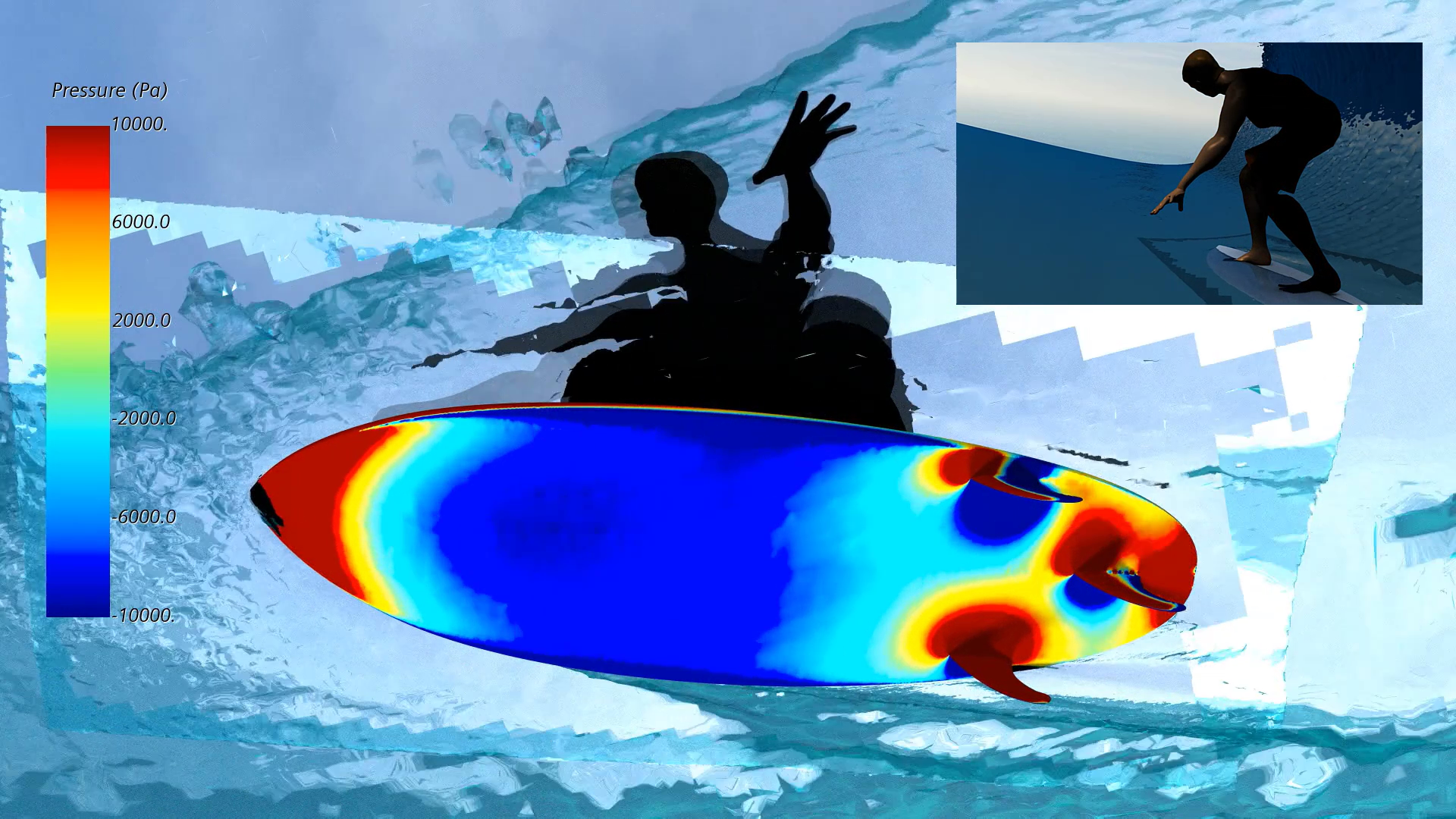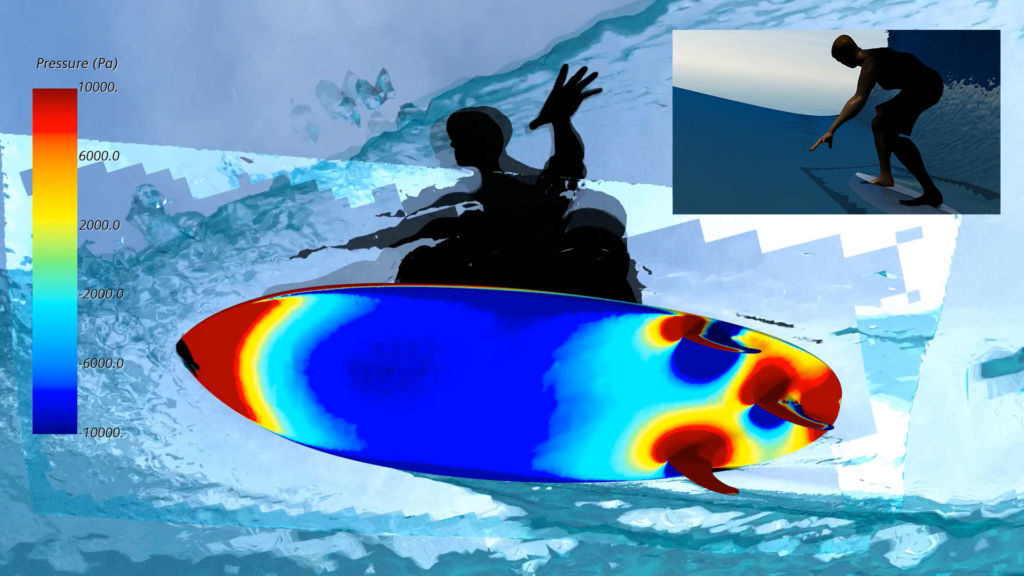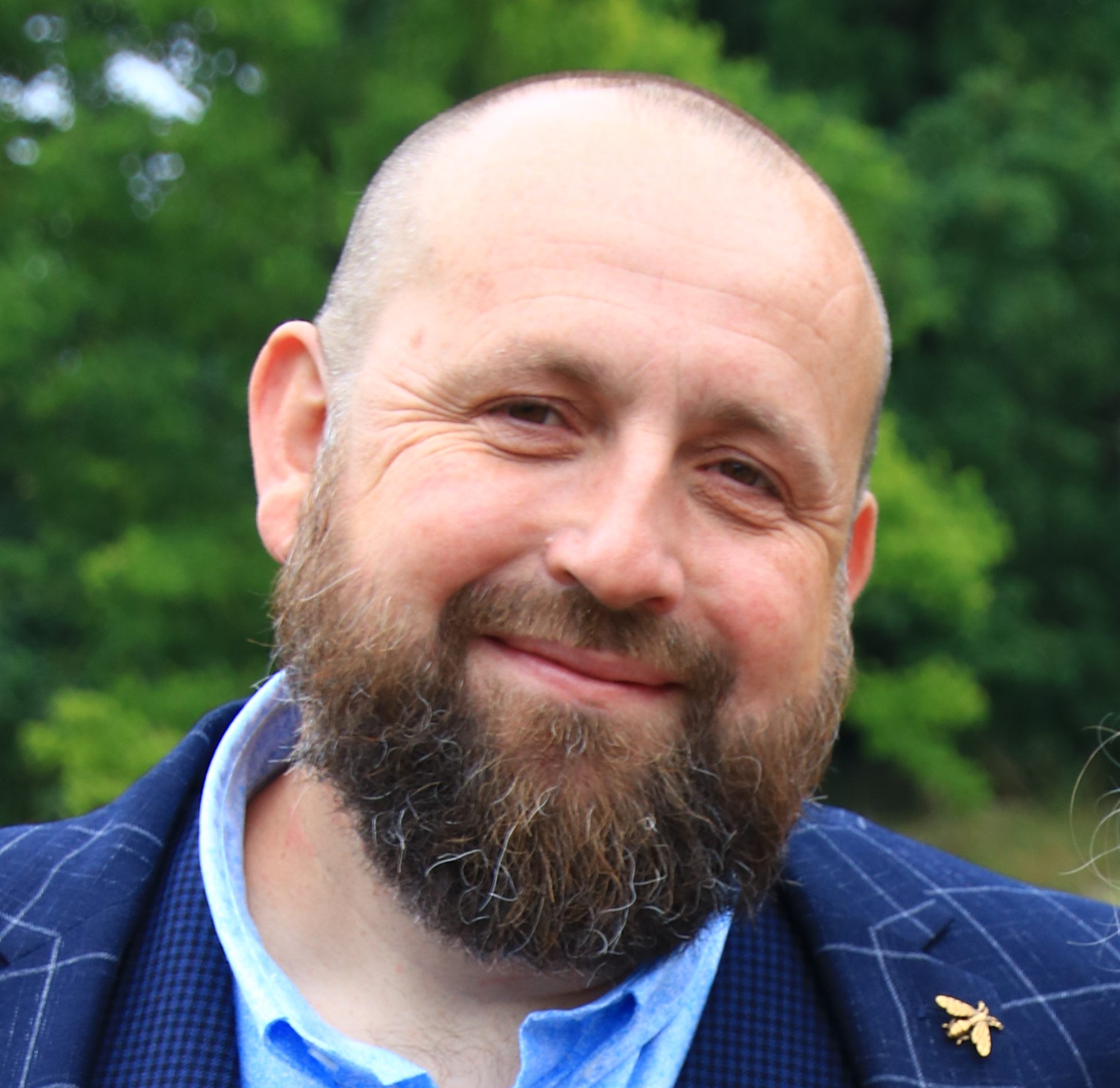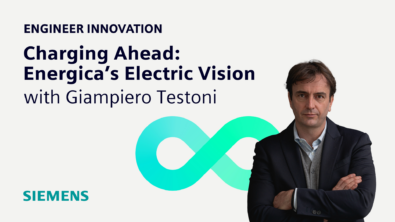Ride the digital wave with CFD simulation

(Episode 1)
People have been riding waves for more than 5000 years, which makes surfing one of the world’s oldest sports. The surfboard industry is worth $3 billion, and surfing will debut as an Olympic sport in Tokyo this summer. But it’s more than just a sport.
In ancient Hawaiian culture, the art of he’e nalu (or “wave sliding”) is endowed with almost religious significance, where frustrated surfers would call upon the kahuna (priest) to aid them with a surfing prayer which asked the Gods to deliver great surf.
At the heart of the culture is the almost spiritual act of “surfboard shaping” in which a skilled craftsman manually shaves a piece of wood (or more recently polyurethane) into a hydrodynamic planing surface, carefully adjusting its shape for specific wave conditions and surfer preferences.
Using this process, guided by surfer feedback, surfboard design has evolved over hundreds of years. In this podcast, we ask the question, “could a digital twin help to design better, more responsive surfboards with the help of CFD simulation?” And discuss how you can test a digital surfboard using a digital wave.
In the first episode of the Engineering Innovation podcast I’m joined by surf enthusiast and sports CFD engineer Luca Oggiano, who is the co-founder and CEO of Nabla Flow. Together we discuss the impact that digital twins have on the surfing industry, and how we can use digital waves to test them.

- Luca’s firsthand experience with surfing and how he combined the hobby with engineering (02:00)
- The engineering that goes into modern surfboards (04:49)
- What obstacles had to be overcome to implement CFD in surfing (08:21)
- The process and evolution of surfing simulations (10:07)
- How the simulations were utilized in board designing (15:05)
- How top professional surfers are using wave pools and CFD to revolutionize their mastery (24:15)
- If we can look forward to seeing CAE designed surfboards in the 2024 Olympics (25:52
[00:00] Stephen Ferguson: With me now is Luca Oggiano, who’s the CEO and co-founder of Nabla Flow, and also a co-founder of the Surf Engineering Association. Luca, most important question first, are you a surfer?
[00:15] Luca Oggiano: Yes, I am a surfer. I’m not an amazing surfer, but I’ve been surfing for most of my life, I will say.
[00:22] Stephen Ferguson: And originally, you’re from Italy, but now you’re in Norway?
[00:25] Luca Oggiano: Exactly. I’m from Sardinia, the island.
[00:29] Stephen Ferguson: How is surfing in Norway? Can you get any good surfing, not in Stavanger where you are – it’s the wrong side of the coast, isn’t it? I imagine.
[00:36] Luca Oggiano: It’s actually the right side of the coast. I was surfing this morning for about two hours. I had a very nice session, no one in the water. As you can imagine, there are way fewer people here than in places with a better climate.
[00:51] Stephen Ferguson: So, you get the surf all to yourself, which is pretty cool. So, tell me a bit about your background and how did you get involved in surfing because you’re a CFD guy, aren’t you? You’re an aerodynamicist, you’re a CFD guy and you’ve got a history in sports engineering, but how did you get involved in surfing, from an engineering point of view?
[01:09] Luca Oggiano: Yeah, surfing itself, I started surfing when I was 20. But then I moved to Torino where I studied aerospace engineering, and then it was pretty difficult to reach the beach and the waves. Then I started to surf quite a bit more intensively when I moved to Australia for one and a half years. And more or less at the same time, I started to work on CFD, I finished my Ph.D. and I got hired to work with offshore wind energy. And then we started to use, actually started CN Plus for a simulation for the offshore wind energy market, where we were simulating either wind turbines, particularly waves hitting this floating – either floating or both of its substructures. Then at some point, I started to think, “I think with exactly the same tool, I should be able to simulate a surfboard as well.” And I started playing around and, well, that’s where it started. So, during the breaks from when I wasn’t at a meeting, during the break, I started to play around, I downloaded a geometry from the net and I started playing with a surfboard on CN Plus.
[02:14] Stephen Ferguson: That’s always a dangerous thing to do, isn’t it? To download a model from the internet and start playing around because it can end up as you say, take years of your life away doing those kinds of simulations. So, the surfboard industry, I mean just googling online is worth about $3 billion, that’s what Google tells me anyway. And it’s getting bigger as well because I think this year in Tokyo surfing is finally going to be an Olympic sport. The sport’s thousands of years old, maybe it originated in Polynesia, and in some ways, it’s more like a religion than a sport. There’s kind of religious parts to it, at least in its origins and it’s been massive sports since the 1960s. How are surfboards designed today? There’s much engineering that goes into the designing of surfboards?
[02:59] Luca Oggiano: There is more and more engineering going into the design of surfboards. Until I would say 10-15 years ago, it was almost just an art. So, people were just shaping planks in their own either backyard or garage and making a surfboard out of those planks. When CNC machines started approaching and then you could start using also CAD software to design surfboards. Then the overall industry started translating into a more engineering-looking industry where you could not only mass-produce surfboards but also reproduce surfboards or produce them at least with a certain level of accuracy. And then that’s where the industry is at right now. I think though it is in a very early stage when it comes to both structural dynamics and hydrodynamics. Or at least in how hydrodynamics and structural dynamic designs are implemented into the surfboard design itself. A lot comes from experience basically at this stage.
[03:59] Stephen Ferguson: So, this effort to apply disruptive engineering technology or simulation technology to the surfboard industry into the sport, isn’t just something that you’re doing, there’s a wider group of people you’re working with. Can tell us a bit about those guys?
[04:13] Luca Oggiano: Well, we are actually three friends. I will say we met in a very weird way. With Marc we met in Australia, I was at a conference – it was one of the ISEA conferences and I met one of his colleagues. Marc is an expert in both structural dynamics and surfboard testing. He managed to build I think the most amazing facility for surfboard testing in the world and he’s been one of the first guys that I know at least trying to go deep into the modes of the board, so how the boards vibrate and how these modes interact with the performance of the boards themselves. We’ve been working also together on this topic and also wrote some papers together. Dave is coming from a different type of industry he’s been designing his own fins and that’s where they met with Marc, and then I got introduced to Dave, from Marc. And the last guy in the Surf Engineering Association is Jimmy Freese. He is the co-founder of I think actually the founder of one of the largest companies for CAD design applied to surfboards, so he’s the founder of AkuShaper. I think they produce or the AkuShaper used to make probably half of the boards on the planet. And he managed to join us at the last symposium we had in Hawaii. So yeah, we got to know each other in a very random way, I will say, but we got along. And now, we managed to found this Surf Engineering Association, which is great fun.
[05:40] Stephen Ferguson: And so, if you’re going to have a surfing conference, the only real place to have it I think is Hawaii. How did that work out? Was there much interest from the general, wider surfing kind of population? Were they interested in what you guys were talking about?
[05:54] Luca Oggiano: We actually had surprisingly quite a few guys dropping in. It was I will say a homemade conference, I will not even call it a conference, it was more of a symposium, was at a very familiar venue. We had both a range of people from five years old, up to eighty years old at the conference. So, it was an amazing atmosphere I will say, completely informal, and we were presenting in shorts, and everyone was wearing shorts there – it was really a blast, we had a blast. It was amazing.
[06:25] Stephen Ferguson: I bet there was sand all over the conference room, wasn’t there? When you guys were hanging out there.
[06:30] Luca Oggiano: Yeah, sort of.
[06:34] Stephen Ferguson: Okay, so what are the issues? What’s prevented the surfing community from using CFD or engineering simulation before now? What kinds of obstacles had to overcome, do you think?
[06:47] Luca Oggiano: I think there are two obstacles. The main obstacle is the obstacle that CFD always had, some outreach was complex, difficult, required enormous computational power, I was not there yet. Now it’s starting to be applied to fields where you can actually run simulations at relatively low costs, especially when it comes to cost in terms of money. And surfing is one of those industries, meaning that there is not the same amount of money that you can have in designing a Formula One car, for instance. But now simulations are more available, they are easy to run, the software is also getting smarter, so everyone, or not everyone, but let’s say that it’s easier to run simulations now than it was 10 years ago. And then the second issue is that probably no one thought about that before. So yeah, once you start opening some doors, then people start seeing the doors as well. And they see the door open, and then they start to understand as well. There is a whole world here we didn’t think of and let’s start exploring it.
[07:49] Stephen Ferguson: So, yeah. I think we’ve seen… So as long as I’ve been involved in CFD, which is almost 30 years now, there are always people trying to apply CFD to sports. So Formula One is the obvious one. Obviously, for cycling aerodynamics, it’s been used quite a lot recently, as well. And in the news recently, you’ve seen America’s Cup, where you’ve got these hydro foiling monohulls, which are traveling at 50 knots. So, kind of the technology for simulating high-performance boats in waves is there but one of the things that I don’t quite understand is how can you simulate a surfboard, without a surfing maneuver? Surely you need to be able to model how the surfboard is moving through the waves and where would you even begin to get that kind of data?
[08:33] Luca Oggiano: Well, we decided to go simple first. The very first simulations were just a board fixed, basically, in the water. And then you can start seeing already you can already start at least with some information about how the flow goes – for instance during the paddling phase. Then we started placing the board at a certain angle in the flow representing some sort of turns. And then we were trying to understand what kind of influence the tail has in this type of static but still somehow dynamic type of situation. And from there on, we started moving forward and we started implementing maneuvers and also that way was prescribed maneuver – meaning that we were prescribing the kinematics – until at the end we managed to implement, with the FPI, we managed to implement forces on the board so the board is literally floating on a flume and we represent the surfer, so basically one point imposing some certain movements to the board. And that’s probably the most representative case we can get at least at this specific stage when it comes to surfboards. Design? I will not call it design, but it is more CFD applied to surfing.
[09:42] Stephen Ferguson: I think I read somewhere that you managed to… Did you not have some surfers surfing on boards with kind of GPS motion sensors involved as well?
[09:51] Luca Oggiano: Yes, that’s really not my expertise, but Dave in Hawaii has been working with surfers that had GPS on their boards. And they were using different types of things, and then we compared the results from the CFD simulations with field data. And that was quite a ride, we were not expecting to get the accurate match, but in the end, actually, we could see some large differences, both from CFD and from the field test. And those differences were actually matching, which shows that, well, maybe this isn’t the right direction to take.
[10:24] Stephen Ferguson: Because that’s another one of the interesting questions about a surfboard, isn’t it? Because what’s the difference between a good surfboard and a bad surfboard? I guess most of it is subjective in the eyes of the surfer, is what the surfboard feels like. And I guess it depends quite a lot on the experience of the surfer, too. So, how do you tell the difference between a good surfboard and a bad surfboard?
[10:46] Luca Oggiano: I don’t really think that’s really the scope that we ever had, but the scope is more to quantify the differences between the surfboard in a way that is not anymore just linked to geometrical differences. Because right now, the only way we have to describe – is changing slowly, but let’s say until 3-4 years ago, the only way you had to describe a surfboard was to have the dimension of the surfboard. Not even the shape, sometimes the shape was defined as the type of surfboard you were surfing, for instance, a fish or a thruster. But also the way the volumes were displaced along the surfboard, that’s something that you just see, look at it, and you decide if you like it or not. One of our main scope or at least my main scope and goal is to move away from this type of description into something that is more engineering-based or more results-based, or something that you can at least specify in a better manner so that you can give – at the beginning is going to be mostly pro athletes, but in the future, maybe also the normal users – a better way to understand what kind of boards they’re buying. So, will not be a better board or a worse board. Maybe at some point, it will, but I think the main scope right now is to quantify what right now is just based on the subjective way of seeing.
[12:06] Stephen Ferguson: Yeah. Because the industry has been around well, from the start for over 1000 years, but as a sport for over 60 years. And there’s quite a lot of innovation anyway because surfboards have changed in the past 60 years, haven’t they already?
[12:18] Luca Oggiano: A lot. In terms of materials, in terms of shape. I think it’s actually pretty impressive to see how far surfboard designers go just by evolution, and trial and error. It’s pretty amazing.
[12:34] Stephen Ferguson: So, you’re looking to add another dose of innovation into the sport to accelerate it even further, I guess it’s going to be the result of this.
[12:42] Luca Oggiano: I think it’s needed. And I think it’s going to happen no matter what if it’s going to be me, I don’t know, but it’s going to happen, especially when the sports are going to reach a professional level and be included in the Olympics. There will be the need for more specific materials and also the surfers, at least the professional ones, will start to understand the great value of having something that is correctly described, correctly pre-described, so you can pick your weapons somehow in a 100% secure and safe way.
[13:15] Stephen Ferguson: So, tell me just a little bit about the simulations that you did then. I think you compared three different surfboard fin designs. Is that right?
[13:24] Luca Oggiano: Yes. We compared two different fin designs and we ran some simulations on them. I think the results presented were only part of the results that we analyzed within the Surf Engineering Association. Also, there we run both either kinematic prescribed motions or torrents and also the FPI terms, meaning using fluid-structure interaction. The simulations were run on a simple flume, so we didn’t include any way for specific simulations, but the differences were actually pretty clear. And some of the differences we were looking at were both how fast was the board turning with the different types of fins, and also, how much drag were the fins really providing to the board. Also, there is no optimal because some riders might like to have a little bit more of a loose feeling on their boards, meaning that they like the board to slide a little bit more. So, it’s not that some fins that provide better grip better than other fins. But what is kind of important or what is important for the surfers is to have a type of fins that don’t release toll in an abrupt way so that you can always somehow control the force that you are applying to the board and the reaction that you get from the board. So, it’s not really about… It’s difficult to describe what is a better fin or if there is a better fin than other ones, but for sure delaying the stall or at least mitigating the stall is one of the key components.
[14:53] Stephen Ferguson: But what you’ve managed to do is you’ve managed to characterize the different fins, so people could make an informed decision about the type of board they liked for the first time. You can look at a surfboard and say it’s got these characteristics. It’s not just a question of riding it and feeling it; you can do that with numbers. Was it more than just pulling out numbers, though? Could you see the kind of flow around the board? Because I guess for 1000s of year-old sport, not many people have ever probably seen the flow around the underside of a surfboard. So, I guess there’s lots of insight that can be gained from just looking at the flow around the surfboard, isn’t there?
[15:27] Luca Oggiano: Exactly. So, it was actually a very interesting study, and some of the structures that use sometimes – now there is a lot of photographers that are placing themselves very close to the surfer. So, sometimes you have this amazing footage with surfers shot from below the water. And you can see some of the structures that you actually saw in the simulations, like for instance, ventilation with air getting caught under the board and mixed with swirls and vorticity. So yeah, that was pretty amazing to be able to visualize and quantify these types of effects, that in general are extremely complex to see in real life. I guess that’s where the real power of CFD is that you get some results, but you also manage to understand what is causing those results.
[16:15] Stephen Ferguson: It’s also interesting to see these surfboards, which have basically been designed almost through evolution, through successive generations of surfers are finding out sometimes that from a CFD point of view, they actually work, don’t they? As well, there’s sometimes the surprise that things are already pretty good, before you even look at them. So, engineering simulation can improve a design, but were the designs quite good to start with anyway?
[16:40] Luca Oggiano: At this stage, I have to say that we didn’t make any dramatic improvements, so we didn’t revolutionize the market yet. I think there is a lot to discover, a lot to improve; standardization, for instance, is one of the directions that I think the surfboard industry or at least each producer should take. So, trying to understand, build the database, run simulations on a certain number of surfboards, collect data from the field because that’s where I think the real power of this type of simulation will start appearing. When you start to collect data and have a database large enough so that you can compare different designs. We are right now just opening doors, checking solutions, try to see what’s possible pushing boundaries. Applying all this new methodology. It is not the only methodology, I think is a new vision or a new way of seeing surfboards will probably require some time and some effort from both the surfers and the surfboard producers.
[17:43] Stephen Ferguson: Can you tell me a little bit about biomimicry? And so, one of the fin designs you tried out I think was inspired by nature, wasn’t it?
[17:51] Luca Oggiano: Yes, there was an idea of Dave, inspired by the whales. So, they have this kind of tubercular structure in front of their fins. And that supposedly, at least nature made them involved in that way so that they could improve their hydrodynamics. And we actually found out it works pretty well also on surfboard fins. So, first of all, they are pretty amazing to ride those fins and at the same time is kind of amazing that they are coming somehow from an evolutionary process already happening in nature.
[18:23] Stephen Ferguson: Was there any benefit from using the whale-inspired fin designs?
[18:28] Luca Oggiano: Yeah, it’s a bit in line with what I was saying earlier. So, you have a way smoother stall, so the fin itself is not stalling abruptly at a certain angle, but it’s more transitioning into a more stall condition without causing this abrupt change in drag or side force. Also, there, while you’re riding deciding what is drag and what side force – we had a long discussion amongst us, “Should we follow the direction of the board? Should we follow the direction of the surfer? Should we follow the tangent direction?” So, it was a pretty complicated discussion. So, when you start working with different reference systems, everything gets mixed up, so you don’t know anymore what is a drag, what is lift, what is side force.
[19:14] Stephen Ferguson: Because I guess those are simple concepts that don’t really apply to a dynamic three-moving structure, which is going through waves, I think, so that’s an interesting observation. So, having basically validated your approach using complicated maneuvers, but under simple stuff, so those were done on more or less a flat sea surface, weren’t they?
[19:34] Luca Oggiano: Yes. At least the ones that are presented in the paper were done on a free surface.
[19:39] Stephen Ferguson: What’s the prospect of simulating surfboard dynamics on real waves? Is that something that’s possible, do you think?
[19:48] Luca Oggiano: Yeah, I think we’ve been, one of the presentations that we had there at the first symposium that we had, was about a surfboard sliding on a tube. At some point, the idea there is to have a reference tip where you could eventually simulate a surfboard floating on the tube. Right now we are only working on prescribed motion or prescribed kinematics, so the board somehow is slicing through the tube. We already got some very interesting results from that and very interesting understandings or at least we are getting closer to understand the complexity of the hydrodynamics that the board experiences such condition. But at some point, I’m 100% sure that we’ll be able to simulate a real surfer committing maneuvers or acting on the wave. And yeah, basically maneuvering on the wave itself, which is I think the Holy Grail. We are not there yet, but I can see that it’s doable.
[20:47] Stephen Ferguson: It’s an incredible idea. I mean, we’ve talked about kind of the digital twins of the surfboards, but that requires you to have a digital twin of a wave as well, which itself obviously in marine CFD applications they have wave interactions, but a surfing tube is a whole different order of magnitude and complexity. How would you even go about simulating a wave?
[21:08] Luca Oggiano: Yeah, there has been a lot of trial and error from my side. I’ve been simulating waves for about 10 years, but they were not the same type of wave. Some of them were actually breaking also because in the offshore wind energy business one of the most complicated situations that you can simulate is the wave slamming on the structure, so those waves were almost breaking. So, almost braking, or at least braking on the monopiles, so on the structure. So, I already had some knowledge on how or what kind of settings I should use, but from there on from moving from those types of waves which are still some are two dimensional, they’re three dimensional but you’re sending a two-dimensional wave. So, moving from there to a real three-dimensional wave where the wave is peeling it was an enormous amount of trial and error until I was fully satisfied with the dynamics of the wave, the size of the wave, the velocity of the wave. And there was done try to represent a real existing break witch is coho, so there the idea was to have a wave that was peeling and moving at very similar speeds than one you can expect there in Tahiti.
[22:20] Stephen Ferguson: So, a Tahiti wave modeled using simulation in Simcenter, that’s an incredible achievement. And also, I think it’s another way that the industry or the sport seems to be heading isn’t it? Because I think the top professional surfers now have their own kind of wave-making facilities, so they can practice their surfing on using repeatable waves. Do you think that’s another possible application for computational fluid dynamics and simulation?
[22:43] Luca Oggiano: I’ve been sneaking into most of the wave pool projects and I think 99% of them are designed using CFD or CFD applications. So yes, that’s definitely an enormous market and an enormous growing market. Also there I have to say that a lot of the research or a lot of the effort started from research that was applied from other fields. So, it’s kind of interesting to see how oceanography and even the offshore wind energy but also offshore oil and gas market have been contributing to something that I don’t think they were really expecting will have happened, which is surfing waves produced by manmade machines.
[23:29] Stephen Ferguson: It’s incredible. And I mean, it’s worth checking out, we’ll put some links in the show notes for this. But it’s incredible to see if you look on YouTube, these kinds of sections of the beach where people are making these reproducible, re-creatable waves, so you can practice the same maneuvers again and again. In any other sport that will revolutionize the sport, so I think it’s exciting times for surfing. So, when we said at the start of this, that Surfing is an Olympic sport, if we step forward four years time… So at the moment I guess most of the surfboards designed, all the surfboards in the Tokyo Olympics will be designed using traditional techniques. Do you think in four years’ time at the next Olympics, after obviously surfing is going to be a massive success, we’re going to start to see the impact of CAE-designed surfboards?
[24:13] Luca Oggiano: I really think so. And that will develop into, first of all, understanding not only from us that are driving this change but also from the riders. And I know I’ve been working with professional athletes for about 15 years and I am 100% sure that when they will start seeing that they can get something better, they will want that something better because of that little bit of advantage that you can get from a better design or at least from knowing the type of design you’re going to ride is going to make a massive difference for them. So, it’s not going to be driven anymore just by us that are maybe a little bit of a visionary in this field, but more from the really performance side of the sports which are the surfers. I completely see that. And we could make a bet and see if this happens or not.
[25:07] Stephen Ferguson: Well, I’ll certainly invite you back on the podcast and we’re looking at, and I don’t even know where the next Olympics is going to be, but we’ll definitely have a chat about that. And maybe we can have a chat after this Olympics as well. I mean, I think all you have to do in that regard is you only have to hook one top surfer, don’t you? As soon as one guy or girl is seen to be getting an advantage from using this technology and using surfboard design or this technology, then everybody else just has to follow because that’s the way of sport. It’s about marginal gains, any sort of improvement you can demonstrate will I’m sure revolutionize the sport. So, Luca, supposing that there’s an expert surfer out there who wants to utilize some of these techniques that you’ve developed and to improving their surfboard, how would they go about doing that? Could they contact you?
[25:52] Luca Oggiano: Yeah, they can just contact us directly. So, we are right now in the full phase of development, and of course, following the journey of a professional surfer from our side will be absolutely amazing.
[26:04] Stephen Ferguson: All right, that was really interesting. I think it’s a fantastic application of CFD and simulation. I love the way that you’ve already given insight, but I love the way that you’re able to characterize surfboards for the first time that you’re getting information about how the fluid dynamics of surfing works. I think the prospects are really huge. And so, thank you very much Luca for joining me. It has been really interesting. Thank you.
[26:27] Luca Oggiano: Thank you.

Stephen Ferguson, your host
Stephen Ferguson is a fluid-dynamicist with more than 25 years of experience in applying advanced simulation to the most challenging problems that engineering has to offer for companies such as WS Atkins, BMW and CD-adapco and Siemens. He has never tried to stand up on a surfboard.

Luca Oggiano, our guest
Co-founder and CEO of Nabla Flow, Luca’s background is in aerospace engineering. He holds a PhD in sports aerodynamics and comes from the professional sports world where he has helped athletes succeed – from the Norwegian Federations to the professional cycling team INEOS Grenadiers (former Team Sky). A surfer with a strong connection to the ocean and the environment, Luca has for the past 10 years conducted national and international research projects to help the Norwegian green transition from oil and gas to offshore wind as well as pushed the boundaries of the surfing industry by applying CFD (computational fluid dynamics) methods to surfboard design.
Luca is currently working on twisting the way fluid dynamics is applied to a number of fields – from urban pedestrian comfort to drone paths, high performance sports, wind energy, product and surfboard design with the help of AI.
Stuff to watch:
Good reads:
- Surf’s Up! Magic Boards on how to make a professional surfboard
- Towel Day: The Aerodynamics of Freefalling Sperm Whale
- Intelligent Design Exploration and CFD- engineering better than nature
- How do you combine technology and passion to realize your vision?

Engineer Innovation
A podcast series for engineers by engineers, Engineer Innovation focuses on how simulation and testing can help you drive innovation into your products and deliver the products of tomorrow, today.

Engineer Innovation Podcast
A podcast series for engineers by engineers, Engineer Innovation focuses on how simulation and testing can help you drive innovation into your products and deliver the products of tomorrow, today.


